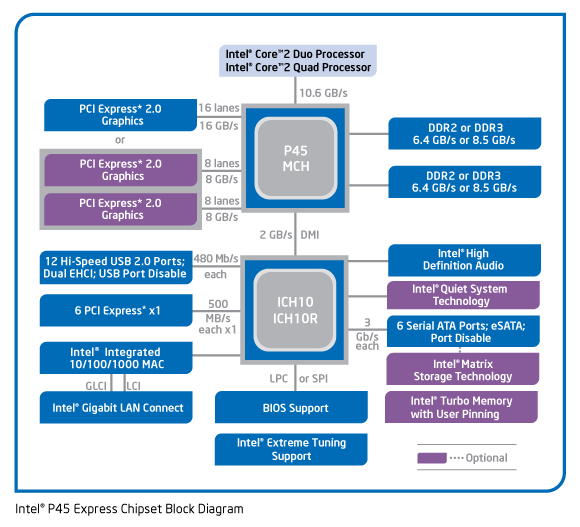Intel P45: The New Chipset Lacks Progress
ICH10 Southbridge
ICH10 Southbridge
Intel’s Turbo Memory, once known by its code name Robson, allows motherboard makers to add flash memory to a motherboard, which can be used to store operating system data and frequently used applications to accelerate boot time under Windows Vista. However, Turbo Memory has not been very popular. The ICH10 chip now adds an additional feature called user pinning, which allows OEMs or end users to select the applications they would like to be stored within that NAND flash memory.
The south bridge is available in the two traditional flavors: ICH10R with RAID support for all six AHCI SATA 3Gb/s ports with Native Command Queuing (NCQ) or ICH10 without RAID capabilities. These RAID features are always complemented by Matrix Storage Technology, which allows deployment of several RAID arrays across the same set of hard drives. As a simple example, you can install two hard drives and use 30 percent of their capacity to create a fast RAID 0 stripe set, and configure the remaining capacity to hold redundant data in a RAID 1 array. Please look at the article Intel’s 955X Dual Core Chipset for Business Users for more details on Intel’s Matrix Storage Technology. We also recommend the article Opting for RAID Level Migration to learn how you can migrate various RAID configurations into different ones.
Block Diagram

Lots of Features, But Little News
Most readers should be very familiar with this block diagram: only PCI Express 2.0 (two slots with eight lanes each) and Turbo Memory with user pinning are truly new in the mainstream. Extreme Tuning is new to this particular platform, but has been around since the X38; it basically offers a software interface to allow external applications to directly access northbridge operating parameters. Every other feature has either been recycled from the previous generation or recycled without any changes. This applies to the six PCI Express 1.1 lanes, the 12 USB 2.0 ports and six SATA connectors, DDR3 support (officially up to DDR3-1333 at this point, but even faster using XMP) and the 1333 MHz front side bus. However, the chipset is easily capable of running 1600 MHz bus speeds, which we included in our benchmark runs.
Get Tom's Hardware's best news and in-depth reviews, straight to your inbox.
Current page: ICH10 Southbridge
Prev Page P45 Express Chipset Details Next Page Options: P35, X38, X48